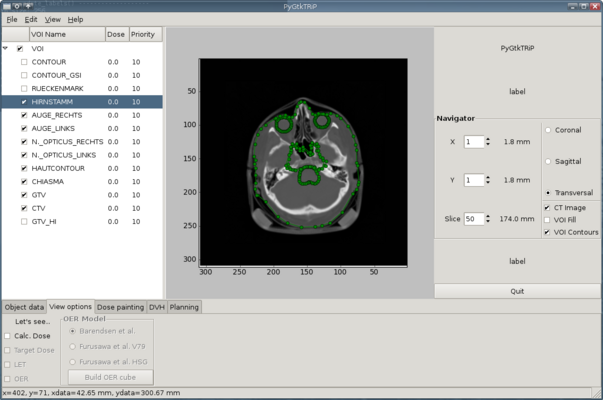Tumour hypoxia has been suggested as being one of the limiting factors for obtaining tumour control in radiotherapy for some tumours. The additional dose needed in order to overcome hypoxia is expressed by the Oxygen Enhancement Ratio (OER), however the risk of normal tissue complication limits the applicable dose. One strategy for mitigating this problem is to identify the hypoxic compartments of a tumour by functional tumour biology markers, and either dose escalate or directly "dose paint" the tumour volume as a function of a hypoxic signal.
High LET radiation such as carbon ions may possibly have a beneficial effect, and have shown in clinical in-vitro experiments to have a reduced OER. The high-LET region of a beam of heavy charged particles such as carbon ions, is located in the distal part of the Bragg peak. A weighted spread out Bragg peak is a weighted function of several Bragg peaks at various energies, which results in a dilution of the dose-average LET found in the planned target volume. We investigate how carefully crafted treatment plans can redistribute the LET in order to overcome hypoxia by other means than merely dose escalation or dose painting.

Some commercial treatment planning systems are today capable of modeling protons, but only TRiP and the Siemens-version of TRiP, and the japanese HIPLAN is capable of performing radiobiologic optimization of carbon ion beams. By using the carbon ion and proton treatment planning system TRiP in conjunction with a custom in-house developed software package "pytrip", we have investigated the dose-average LET for various configurations. Mixed modality treatment plans using protons and carbon ions are optimized in order to investigate, how the high-LET region can be shaped nearly arbitrarily throughout the PTV, which we call LET-painting.
By reduction of the PTV size of carbon ion fields, the dose average LET is significantly increased, and can be more effectively used as a "LET boost" on hypoxic tumour compartments. The dose-average LET though does not depend strongly on the depth of the PTV. The high-LET region can be shaped in very different ways, while maintaining the distribution of the absorbed dose or biological effective dose. Treatment plans involving only carbon ion beams, show very different LET distributions depending on how the fields are arranged. Also for mixed radiation modalities, significant "LET boosts" can be achieved at nearly arbitrary positions within the target volume.
Following the general understanding of the relationship between hypoxia, LET and OER, we conclude, that an additional therapeutic advantage can be achieved by confining the high-LET part of the radiation in hypoxic compartments of the tumour, and applying low-LET radiation to the norm-oxic tissue. We also anticipate that additional advantages may be achieved by deliberate sparing of normal tissue from high LET regions. Consequently, treatment planning based on simultaneous dose and LET optimization has a potential to achieve higher tumour control and/or
reduced NTCP.
Back to APTG main page